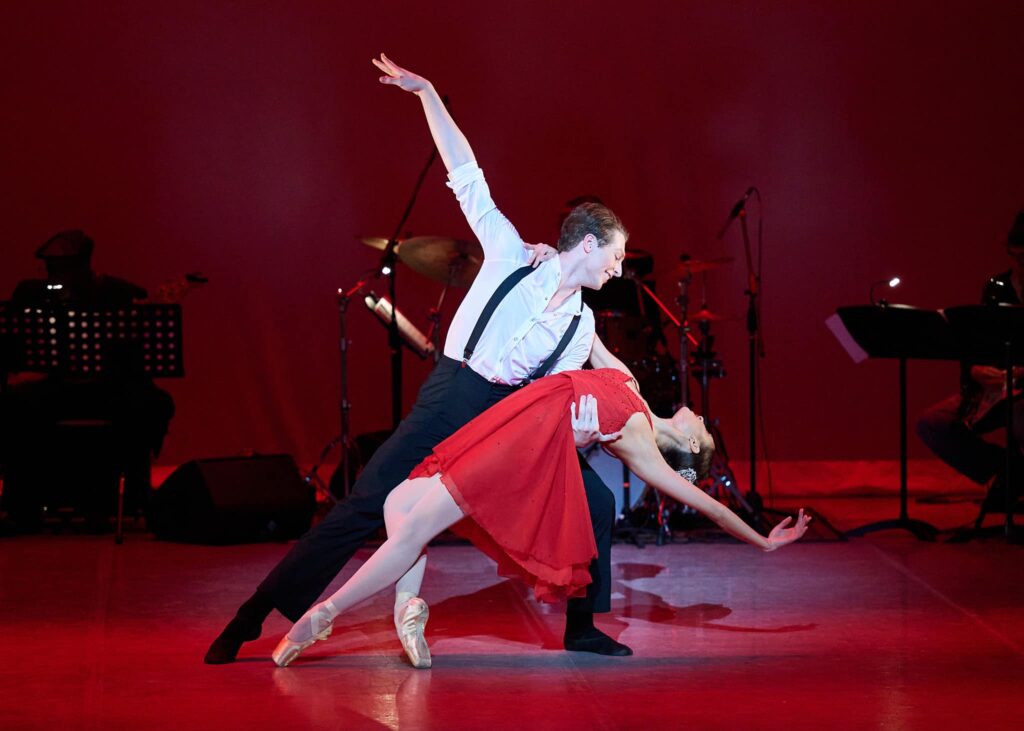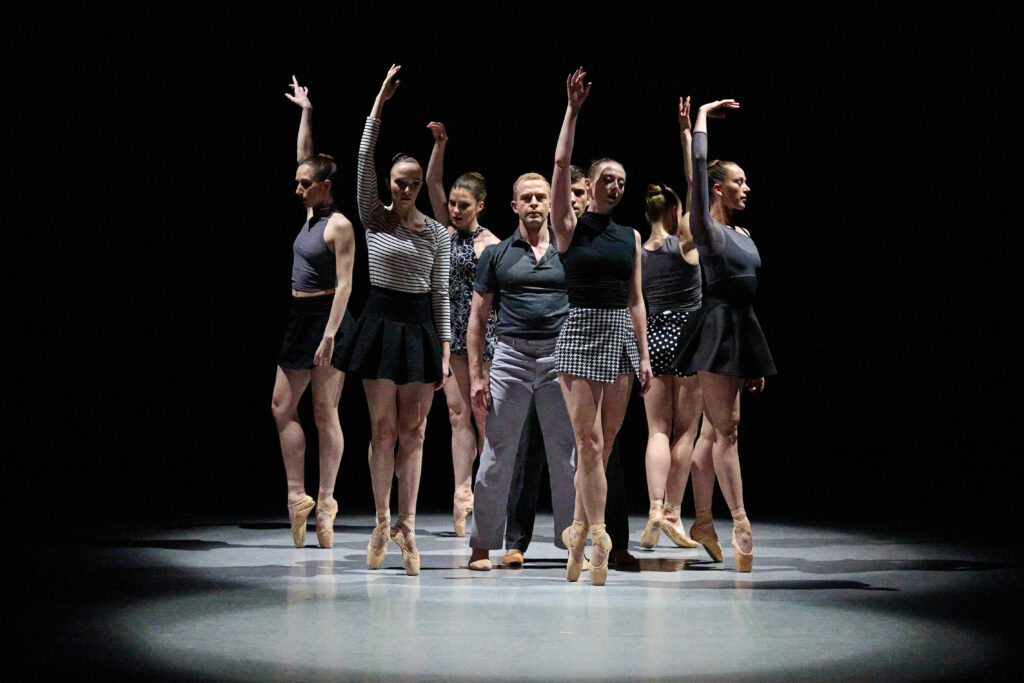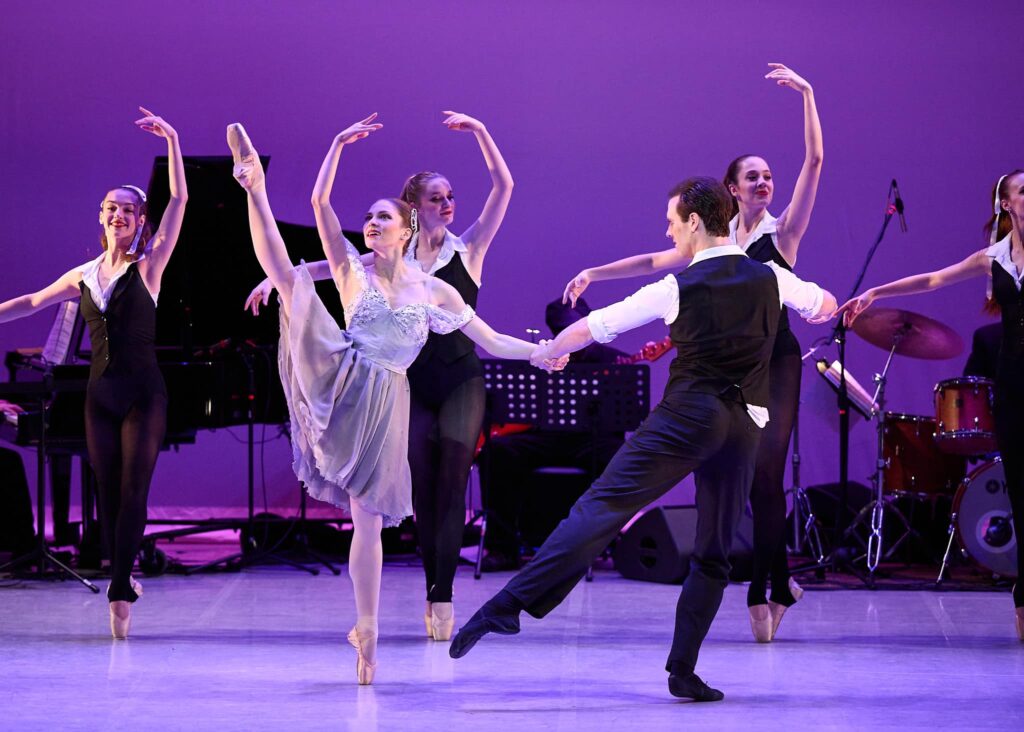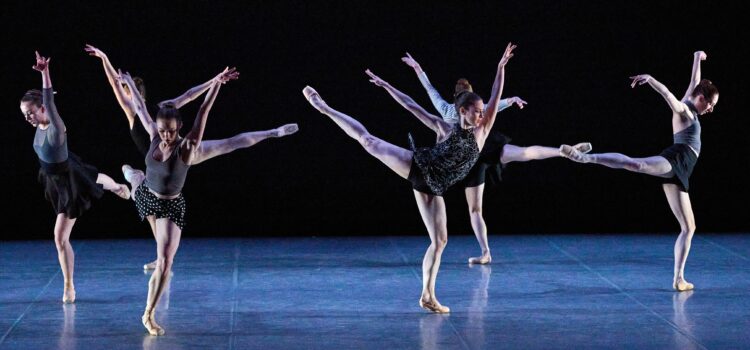By CB Adams
In ballet, tradition often reigns supreme. And like opera, ballet is sometimes (make that, often) misunderstood – as stuffy, fussy, and old-fashioned as your Aunt Minnie’s doilies.
St. Louis Ballet, under Gen Horiuchi, executive and artistic director, provides proof that the new and innovative can comfortably be performed with the traditional on the same program, providing the best of both of these dance worlds – especially when the pieces are thematically and resonantly linked.
St. Louis Ballet has created a distinct niche with its contemporary productions, such as LoveX3 (Feb.16-18 at the Kirkwood Performing Arts Center), that deliver a satisfying, captivating blend of the dance pieces. LOVEX3 was part of the company’s annual “Love” series. And by curtain call at the Feb. 17 (with Cast 2) performance, I was left with an enthusiastic, “What’s not to love?”
The well-curated and paced program included three parts that began with a classic then transitioned to a piece premiered by the company last year and concluded with the premiere of “St. Louis Blues.” This progression of choreographic style and approach, from Balanchine to Brian Enos and Horiuchi, was perfect – and perfectly enjoyable.
“St. Louis Blues” is an exuberant celebration of love through the transcendent language of ballet with direct ties and references to this city. “St. Louis Blues” was choreographed by Horiuchi, who collaborated with composer Atsushi Toya Tokuya to turn W.C. Handy’s six-minute song into a much longer narrative of passion and longing.

What distinguishes “St. Louis Blues” is its ability to seamlessly intertwine two distinct art forms, creating a visual and auditory experience
that is both captivating and immersive. Set against the backdrop of St. Louis’s rich musical heritage, the ballet unfolds as a dynamic
narrative that pays homage to the city’s cultural legacy while showcasing the technical prowess and emotive depth of the dancers.
Horiuchi’s choreography is a masterful blend of fluidity and precision, mirroring the improvisational nature of jazz while maintaining the grace and poise characteristic of classical ballet. Through intricate sequences and expressive movements, the dancers convey the raw energy and emotional resonance of the blues, transporting audiences to the vibrant world of jazz clubs and smoky dance floors.
Tokuya’s musical finesse was captivating, and his composition added an extra layer of depth and richness to the performance. His mesmerizing rendition of the “St. Louis Blues” showcased his versatility and mastery across genres, further enhancing the emotional resonance of Horiuchi’s choreography.
Tokuya’s composition and arrangement were brought to life by the soulful strains of an on-stage New York-based jazz ensemble and the vocal stylings of jazz luminary Denise Thimes, who is no stranger to our city. I have reviewed other performances of Thimes, and she’s a treasure.
Of the three pieces in LOVEX3, “St. Louis Blues” had the largest cast with four couples engaging singly and as an ensemble. Charles Cronenwett and Zoe Middleton were one couple prominently featured. Cronenwett is a native of St. Louis and currently a company artist for the St. Louis Ballet. He has been trained by renowned dancers and directors like Horiuchi, Devon Carney and Christopher Ruud, and that training showed with his unique and charismatic approach.
Middleton has graced the St. Louis stage in a variety of roles. Under the direction of Horiuchi, she has showcased her skills in performances such as “The Nutcracker” (as Coffee), “Classique, and “Cinderella” (as Winter Fairy). Middleton also performed in Brian Enos’s productions, including the 2023 premiere of “In Reel Time.” Her performance in “St. Louis Blues” shone with artistry and a captivating combination of grace and skill.

LOVEX3 began with George Balanchine’s classic “Square Dance,” a piece that has been part of the St. Louis Ballet’s repertoire for years and is a good showcase for the company’s commitment to artistic excellence and refined expression.
Balanchine’s choreography set the stage for LOVEX3’s exploration of tradition and innovation. In this performance, the Cast 2 dancers navigated Balanchine’s intricate spatial choreography that demands precise movements within geometric formations and delivered a delicate fusion of ballet technique with the spirited rhythms of square dancing.
“Square Dance” featured the performances of the two leads, Olivia Cornelius and Michael Burke. Cornelius’s portrayal of the iconic role was delicate and clear. Her en pointe balances were sustained and appeared remarkably light and effortless. Burke’s performance was marked by a confident technique, characterized by a razor-sharp line and remarkable ballon. His execution was meticulous, with every movement impeccably placed.
Sandwiched in the LOVEX3’s pieces was Brian Enos’s “In Reel Time,” which St. Louis Ballet premiered last year. It’s a contemporary gem that pulses with rhythmic energy provided by the ensemble and music by Philip Daniel, Nova, Outland and Spearfisher and arresting visual beauty.
Enos’s choreography pushes the boundaries of traditional ballet, offering a dynamic and innovative perspective on the art form. Berry’s lighting design made dramatic and effective use of projection and visual effects to create a stage where the physical and digital realms converge.
From intimate solos to dynamic ensemble sequences, each movement is executed with precision and grace, captivating viewers with its depth and complexity, though throughout the evening there were some inconsistent lines and synchronized movements among the dancers.
Ultimately, though, St. Louis Ballet’ s rendition of “In Reel Time” was satisfying and engaging with its blend of artistic innovation and storytelling. It definitely left me with an indelible impression.
The St. Louis Ballet presented LOVEX3 February 16-18 at Kirkwood Performing Arts Center.


CB Adams is an award-winning fiction writer and photographer based in the Greater St. Louis area. A former music/arts editor and feature writer for the St. Louis Globe-Democrat, his non-fiction has been published in local, regional and national publications. His literary short stories have been published in more than a dozen literary journals and his fine art photography has been exhibited in more than 40 galley shows nationwide. Adams is the recipient of the Missouri Arts Council’s highest writing awards: the Writers’ Biennial and Missouri Writing!. The Riverfront Times named him, “St. Louis’ Most Under-Appreciated Writer” in 1996.

